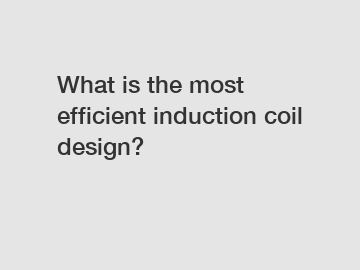What is the most efficient induction coil design?
Welcome back, fellow enthusiasts of cutting-edge technology! Today, we take a deep dive into the fascinating world of induction coil design, seeking to uncover the secret behind the most efficient design for this fundamental component. As we explore the topic, rest assured that you are in the hands of an experienced and authoritative guide who aims to deliver a dose of creativity along the way. So buckle up, as we embark on an exhilarating journey towards unravelling the secrets of the most efficient induction coil design!
1. The Foundations of Induction Coil Design:
To fully comprehend the efficiency of an induction coil, it is crucial to grasp the underlying principles. An induction coil generates an electromagnetic field when an alternating current flows through its wire windings. This magnetic field induces eddy currents within conductive materials placed nearby, resulting in energy transfer without physical contact. Various factors influence the overall effectiveness of this process, making optimization a true balancing act.

2. Geometry Matters: Designing Coils for Efficiency:
When it comes to achieving an efficient induction coil design, choosing the right geometry plays a pivotal role. A compact coil with fewer windings reduces resistance, mitigates energy losses, and enhances performance. Additionally, careful consideration of the core material used within the coil significantly impacts its efficiency. Selecting materials with high magnetic permeability can boost magnetic field intensity, improving energy transfer.
3. Striking the Right Balance: Wire Core and Insulation:
Apart from the coil's geometry, the choice of wire core material and insulation greatly influences the overall efficiency. Copper, known for its excellent electrical conductivity, is often the preferred choice for the wire core. However, certain applications may necessitate alternative materials to accommodate temperature variations or improve stability.
Moreover, the insulation material surrounding the wire windings is crucial in reducing energy losses due to electrical leakage. Materials such as polyurethane, polyethylene, and Teflon are commonly employed due to their high dielectric strength and low power loss properties. An optimal combination of wire core material and insulation helps minimize energy losses and maximizes efficiency.
4. Enhanced Cooling: Managing the Heat Factor:
Efficiency is not solely limited to electrical factors; the management of heat dissipation is equally critical. To prevent performance degradation, an induction coil must be adequately cooled. Air, liquid, or even a combination of both can be utilized for cooling purposes. Incorporating cooling channels within the coil, and using advanced techniques like forced convection, effectively dissipate excess heat, maximizing efficiency and extending the coil's lifespan.
5. Advanced Material Science: Exploring Innovative Options:
As technology advances, researchers are continuously exploring novel materials for induction coil design. Recent breakthroughs include the use of superconductors and advanced ceramic materials. Superconducting materials, when cooled to extremely low temperatures, exhibit zero electrical resistance, enabling unprecedented energy transfer efficiency. Similarly, advanced ceramics offer excellent high-temperature resistance, making them ideal for specific applications that demand exceptional durability.
6. Balancing the Trade-offs: Customization and Versatility:
It is important to understand that the quest for efficiency should not come at the cost of neglecting other vital considerations, such as customization and versatility. Induction coils designed for specialized tasks might require adaptations to prioritize unique factors like precise frequency response, load characteristics, or size constraints. Striking a balance between efficiency and customization ensures that each coil is tailor-made for its intended application.
Conclusion:
As we near the end of this captivating journey through the world of induction coil design, we have unraveled the secrets behind maximizing efficiency. Balancing factors like geometry, core and insulation materials, cooling techniques, and the constant quest for innovative materials, provides us with a compelling framework for designing the most efficient induction coils. So, whether you're an engineer, a curious enthusiast, or simply an admirer of technological marvels, be sure to stay tuned, as the future of induction coil design is bound to be electrifyingly efficient!
Want more information on medium frequency annealing equipment 160kw supplier, induction brazing machines, induction heating pipe? Feel free to contact us.
142
0
0


Comments
All Comments (0)